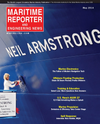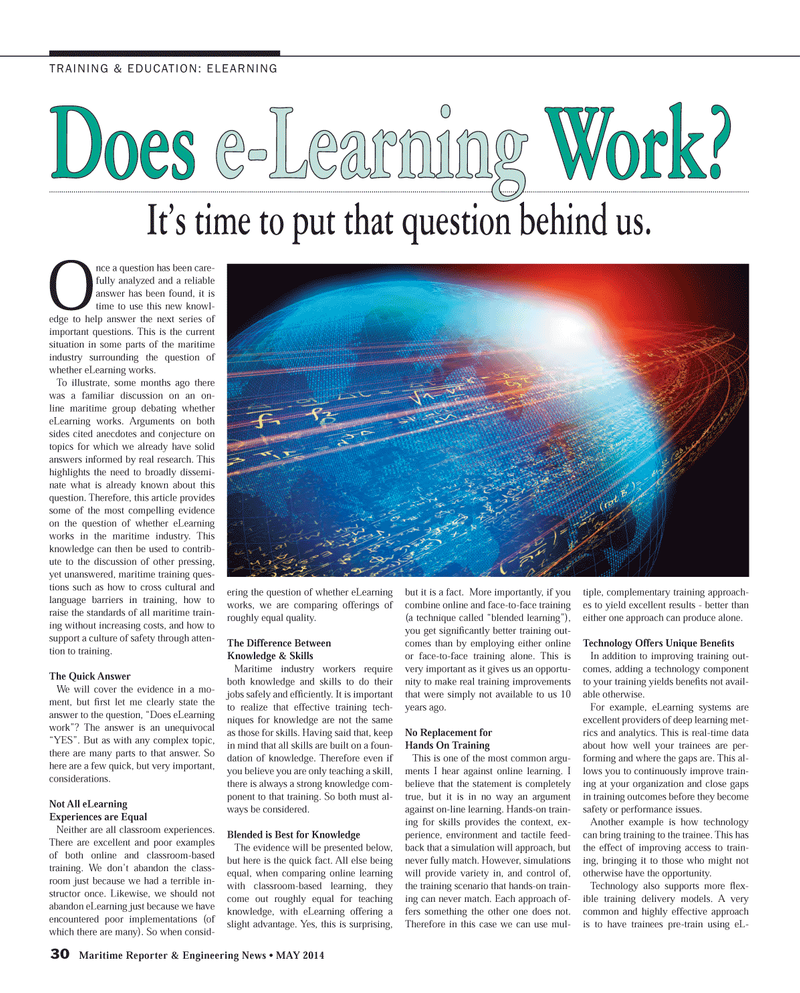
Page 30: of Maritime Reporter Magazine (May 2014)
Marine Electronics Edition
Read this page in Pdf, Flash or Html5 edition of May 2014 Maritime Reporter Magazine
30 Maritime Reporter & Engineering News • MAY 2014
TRAINING & EDUCATION: ELEARNING
O nce a question has been care- fully analyzed and a reliable answer has been found, it is time to use this new knowl- edge to help answer the next series of important questions. This is the current situation in some parts of the maritime industry surrounding the question of whether eLearning works.
To illustrate, some months ago there was a familiar discussion on an on- line maritime group debating whether eLearning works. Arguments on both sides cited anecdotes and conjecture on topics for which we already have solid answers informed by real research. This highlights the need to broadly dissemi- nate what is already known about this question. Therefore, this article provides some of the most compelling evidence on the question of whether eLearning works in the maritime industry. This knowledge can then be used to contrib- ute to the discussion of other pressing, yet unanswered, maritime training ques- tions such as how to cross cultural and language barriers in training, how to raise the standards of all maritime train- ing without increasing costs, and how to support a culture of safety through atten- tion to training.
The Quick Answer
We will cover the evidence in a mo- ment, but fi rst let me clearly state the answer to the question, “Does eLearning work”? The answer is an unequivocal “YES”. But as with any complex topic, there are many parts to that answer. So here are a few quick, but very important, considerations.
Not All eLearning
Experiences are Equal
Neither are all classroom experiences.
There are excellent and poor examples of both online and classroom-based training. We don’t abandon the class- room just because we had a terrible in- structor once. Likewise, we should not abandon eLearning just because we have encountered poor implementations (of which there are many). So when consid- ering the question of whether eLearning works, we are comparing offerings of roughly equal quality.
The Difference Between
Knowledge & Skills
Maritime industry workers require both knowledge and skills to do their jobs safely and effi ciently. It is important to realize that effective training tech- niques for knowledge are not the same as those for skills. Having said that, keep in mind that all skills are built on a foun- dation of knowledge. Therefore even if you believe you are only teaching a skill, there is always a strong knowledge com- ponent to that training. So both must al- ways be considered.
Blended is Best for Knowledge
The evidence will be presented below, but here is the quick fact. All else being equal, when comparing online learning with classroom-based learning, they come out roughly equal for teaching knowledge, with eLearning offering a slight advantage. Yes, this is surprising, but it is a fact. More importantly, if you combine online and face-to-face training (a technique called “blended learning”), you get signifi cantly better training out- comes than by employing either online or face-to-face training alone. This is very important as it gives us an opportu- nity to make real training improvements that were simply not available to us 10 years ago.
No Replacement for
Hands On Training
This is one of the most common argu- ments I hear against online learning. I believe that the statement is completely true, but it is in no way an argument against on-line learning. Hands-on train- ing for skills provides the context, ex- perience, environment and tactile feed- back that a simulation will approach, but never fully match. However, simulations will provide variety in, and control of, the training scenario that hands-on train- ing can never match. Each approach of- fers something the other one does not.
Therefore in this case we can use mul- tiple, complementary training approach- es to yield excellent results - better than either one approach can produce alone.
Technology Offers Unique Benefi ts
In addition to improving training out- comes, adding a technology component to your training yields benefi ts not avail- able otherwise.
For example, eLearning systems are excellent providers of deep learning met- rics and analytics. This is real-time data about how well your trainees are per- forming and where the gaps are. This al- lows you to continuously improve train- ing at your organization and close gaps in training outcomes before they become safety or performance issues.
Another example is how technology can bring training to the trainee. This has the effect of improving access to train- ing, bringing it to those who might not otherwise have the opportunity.
Technology also supports more fl ex- ible training delivery models. A very common and highly effective approach is to have trainees pre-train using eL-
Does e-Learning Work?
It’s time to put that question behind us.
MR #5 (26-31).indd 30 4/30/2014 3:15:27 PM

 29
29

 31
31
